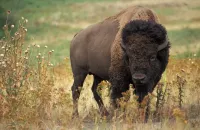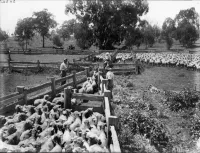The Catalina Island Conservancy is a non-profit organization dedicated to protecting and restoring Santa Catalina Island. Founded in 1972 through the Wrigley and Offield families' donation of 42,135 acres, which is 88% of the island, the Conservancy works to preserve the island's unique environment. Its mission encompasses conservation, education, and recreation, aiming to balance human enjoyment with ecological sustainability. The Conservancy manages the vast majority of the island and plays a crucial role in maintaining its natural beauty and biodiversity for future generations.
1924: Bison Brought to Catalina Island
In 1924, bison were first brought to Catalina Island for a movie, eventually becoming an iconic symbol of the island's culture, but with no natural predators, the herd grew to as many as 500.
1972: Conservancy Established
In 1972, the Catalina Island Conservancy was established through the efforts of the Wrigley and Offield families, who deeded 42,135 acres of the island (88% of it) to the organization.
1999: Distemper Virus Outbreak
In late 1999, an outbreak of distemper virus caused the Catalina Island fox population to plummet from about 1,300 to just 100 animals.
2000: Catalina Island Fox Recovery Plan Implemented
In 2000, the Catalina Island Conservancy and the Institute for Wildlife Studies started the Catalina Island Fox Recovery Plan, combining relocation, vaccinations, captive breeding and release, and wild fox population monitoring, after the distemper outbreak in 1999 decimated the fox population.
2004: Catalina Island Fox Listed as Endangered
In 2004, The US Fish and Wildlife Service declared the Catalina Island fox an endangered sub-species due to the outbreak of distemper.
2009: Stop the Spread Program Begins
In 2009, the Conservancy's naturalists, CHIRP staff and the many youth camps on the island started 'Stop the Spread', a program focused on invasive plant control in and around each camp. Campers learn about native species, invasive species problems, and how to eradicate invasive species.
2009: Bison Contraceptive Program Begins
In 2009, the Conservancy's scientists started injecting female bison with porcine zona pellucida (PZP), a contraceptive, to control the herd size in a safe manner.
2013: Contraceptive Program Study Published
A peer-reviewed study published in 2013 reported that the contraceptive program was effective in controlling the Catalina Island bison herd; the calving rate dropped significantly after the female bison were injected with PZP.
2013: Stop the Spread Program Update
By 2013, the Stop the Spread program had provided nearly 15,000 campers tens of thousands of hours of education. Campers managed about 450 acres for 75 different invasive species, logging more than 7,000 hours of invasive plant removal a year.
2014: Bison Calving Rate Reported
The Catalina Island Conservancy reported in 2014 that the contraceptive program on the bison had reduced the calving rate to 3.3% the year before.
April 2019: Trailhead Opens
In April 2019, the Catalina Island Conservancy opened the Trailhead in Avalon, Catalina Island. This LEED Gold certified building provides recreation information, hiking and biking permits, Eco Tours, Wildlands Express shuttles, educational exhibits, and a shop, along with a plein air exhibit, a restaurant, and a native plant garden.
2020: Plans to Bring Pregnant Bison to Catalina
At the end of 2020, after several years without bison births on the island, Catalina Island Conservancy planned to bring two pregnant bison to Catalina.
2023: Deer Management Plan Created
In 2023, the Conservancy created a plan to reduce the impact that invasive deer have on native vegetation. A culling approach was adopted, involving killing from helicopters.
Mentioned in this timeline
California is a U S state on the Pacific Coast...

Bison are large bovines belonging to the genus Bison within...

Culling is the process of removing organisms from a group...

A restaurant is a business that prepares and serves food...
Trending

6 months ago Terry Bradshaw critiques Tom Brady's Fox contract, admitting his past deal regrets.

15 days ago George Clooney stars in 'Jay Kelly,' resists retirement, and inspires Noah Baumbach.
3 months ago Rome Odunze equals Walter Payton's Bears feat; Caleb Williams shines with TD pass.

8 months ago Spencer ejected for headbutting Sengun; Jackson-Davis shines in eventful NBA Playoffs game.

18 days ago Emma Willis shares update on Bruce Willis and deems Die Hard a Christmas film.

9 months ago Brandon Graham to announce future plans at Eagles facility; retirement possible.
Popular

Candace Owens is an American conservative political commentator and author...

Tucker Carlson is an American conservative political commentator known for...

XXXTentacion born Jahseh Dwayne Ricardo Onfroy was a controversial yet...

Ben Shapiro is a prominent American conservative political commentator media...

Kashyap Pramod Patel is an American lawyer who became the...

Bill Gates an American businessman and philanthropist revolutionized personal computing...